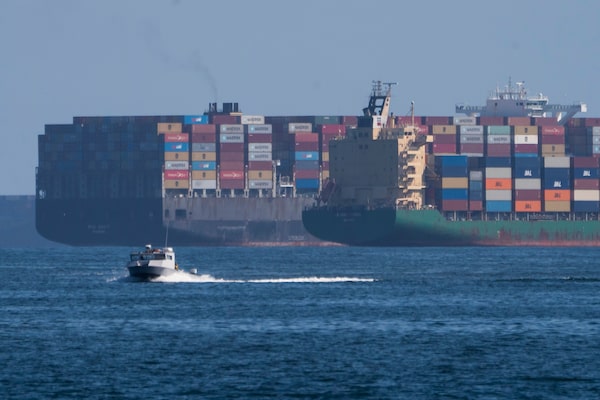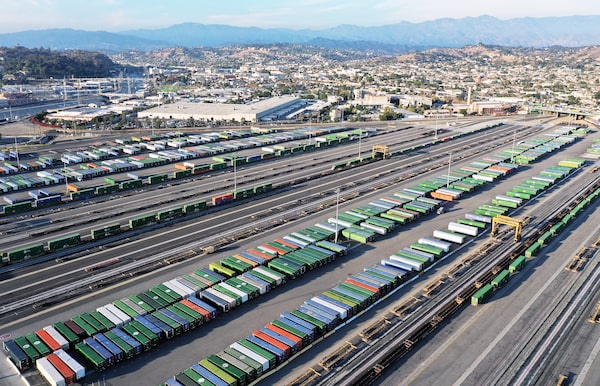
The Biden administration has said the ports of L.A. and Long Beach would move to 24/7 operations to clear a mountain of floating goods worth, by industry estimates, more than US$26-billion.Damian Dovarganes/The Associated Press
The unprecedented assembly of ships anchored off Los Angeles has created a political urgency in the White House and the California governor’s office to ensure the goods keep moving amid expectations for a holiday season like no other.
A federal advisory committee even recommended last week the White House put soldiers in trucks to clear backlogged containers, after the Biden administration said the ports of L.A. and Long Beach would move to 24/7 operations to clear a mountain of floating goods worth, by industry estimates, more than US$26-billion.
But between those ships and Christmas trees across the United States lie logistical logjams so dense that the industry is now warning some of the containers waiting at sea may not be handled quickly enough to place their contents on shelves before Dec. 25. By last Thursday, 85 ships with containers were waiting in southern California’s San Pedro Bay, with loads that exceed by 28 per cent the total processed by the Port of Los Angeles in September.
Anything that touches land after Nov. 1, however, “will never see the floor for Christmas,” said Kevin Mullaney, chief executive officer of the Grayson Co., a retail consultancy. It’s an open question whether those goods currently floating offshore will make it to shelves in time for gift-opening, said Jon Monroe, a logistics consultant. “Some might, some won’t. It’s 50-50,” he said.

Strong consumer demand, coupled with an altered workforce caused by the global pandemic, has contributed to supply chain issues and random shortages of items such as clothing, cars and toys around the country.Mario Tama/Getty Images
The immensity of the shipping problems has prompted a myriad of accusations. Ports blame truckers. Truckers blame ports. Economists blame jammed warehouses. The rail lines, too, come in for their share.
A simpler answer may simply be that never before have so many in the U.S. wanted to buy so much. The Port of L.A. just completed its busiest September of all time; Long Beach had its second-busiest on record.
“We have been in a buying binge for quite a while now,” said Todd Spencer, president of the Owner-Operator Independent Drivers Association, which represents more than 150,000 truckers.
“The reality of what’s going on in the U.S. is that the demand for imported goods that arrives via ship is greater than our ability to handle or process those loads.”
In other words: “We buy a lot of crap.”
And people want to buy a lot more. Those who survey consumers have consistently found a deep thirst for spending this Christmas that has driven an early start to the shopping season – with some telling consultancy McKinsey they’ve already completed holiday purchases well before Halloween – while Accenture has estimated an 11-per-cent bump in consumer spending this year over 2020.
“It’s wild down here,” said Sonia Lapinsky, a managing director in the retail practice at AlixPartners, a management consultancy. “This is big bang Christmas.”
The firm’s research has found nearly 90 per cent of people expect to spend more this year, at a time when government handouts and a buoyant stock market have left bank accounts flush, while the wide reach of vaccines means families and friends can once again come together for the holidays. It hasn’t hurt that pandemic travel curbs have left more money to spend on stuff, a trend reflected in dampened outlays on services relative to goods.
Imports to the U.S. have hit record levels, reaching US$287-billion in August, the latest month for which there are data. Retail sales are roaring, up 13.9 per cent in September over the previous year. The first week of October showed even more retail spending.
It has all pushed logistics networks beyond their capacity. A study by Martin Associates found vessels at L.A. and Long Beach berths are regularly cancelling – or simply declining to hire – port crews, a sign of their inability to move those goods inland.
Containers that in 2019 spent 2½ days on average waiting at port terminals are now waiting more than five, a historic high.
With vacancy rates at nearby industrial warehouses falling to 1 per cent, meanwhile, those containers are spending, on average, nine days waiting on trucks after leaving port. The industry considers one to three days an optimal time. The longer waits are “indicative of the fact they can’t get into the warehouse –they’re just out there sitting,” said John Martin, an economist who does work for ports around the world.
“There’s been an unprecedented demand and growth in TEU throughput,” he said, referring to a standard measurement of containers.
Adding to the pressures are shifts in how people buy. The pandemic move toward greater online sales has persisted, and retailers have sought to increase inventories to speed local deliveries. That has created more strain on the system, particularly for warehouses. Even neighbourhoods near the Port of L.A. are feeling the pinch, with containers blocking driveways and, last week, crushing a car after one fell from a truck.
Over the past two weeks, U.S. President Joe Biden and California Governor Gavin Newsom have intervened, bringing the southern California ports to continuous operation and ordering state agencies to find new ways to store and move containers, such as by lifting weight limits on certain routes to allow trucks to pass.
But there is broad skepticism about how much those orders can achieve. Other ports, too, are struggling to keep up. Ports in Georgia, Houston, New Jersey and New York have all set new records for container movements this year. At Savannah, Ga., so many ships are waiting offshore that they have become a tourist draw.
Companies such as Triple G Express Inc., a New Orleans-based trucking service, underscore how little can be done to fix the problem. President Randy Guillot has little ability to speed the movement of goods, depending instead on how quickly others can deliver and receive containers. “Everyone else makes the rules up, and I just gotta live with them,” he said.
When it comes to anything still on the water, getting it onto shelves by Christmas is growing tougher. “I’d be nervous if my product was sitting out there,” Mr. Guillot said. “It’s going to hit the sale-items Jan. 1, is probably what it’s going to hit,” he said.
Industry research suggests consumers are determined not to let any such problems dampen Christmas. In per-capita terms, the governments in the U.S. were among the most generous on Earth in pandemic subsidies, and bank accounts are still flush while savings rates remain at levels not seen since the early 1990s. “People have saved multiple years worth of savings over the pandemic period,” said Marty Weintraub, national retail practice leader at Deloitte Canada. “We’re seeing an unleashing of a chunk of that cash into the market.”
When McKinsey asks people what they would do if their desired item was out of stock, “85 per cent of them say, ‘I’m going to find something else. I’m not going to wait,’” said Tamara Charm, a senior expert with McKinsey. “They’re going to go to a different store or different brand.”
Those watching the snarl of goods, however, are keeping their holiday wishes more modest. One of Mr. Monroe’s clients had containers on a train that took more than 100 days to move from Seattle to Minneapolis.
“All I want for Christmas,” he said, “is a turkey.”
Your time is valuable. Have the Top Business Headlines newsletter conveniently delivered to your inbox in the morning or evening. Sign up today.
 Nathan VanderKlippe
Nathan VanderKlippe